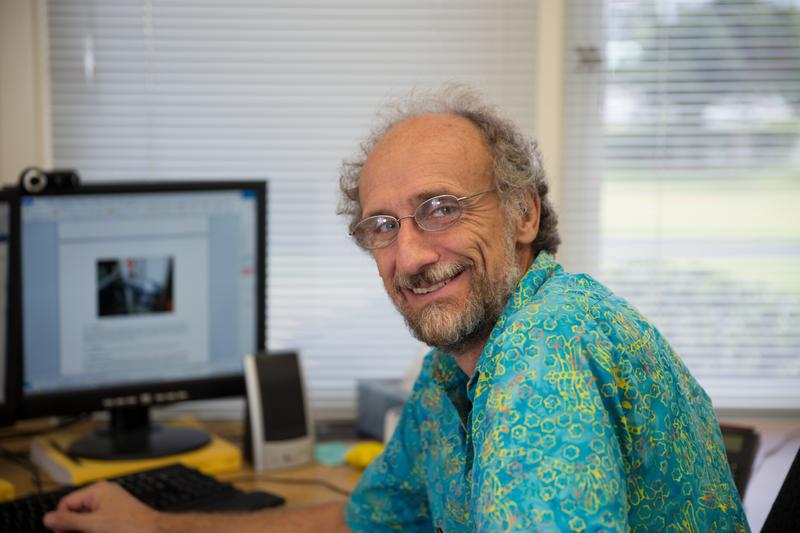Maunakea, Hawaiʻi – Congratulations to Dr. Peter Wizinowich, chief of technical development at W. M. Keck Observatory, who has been awarded the 2022 American Astronomical Society (AAS) Joseph Weber Award for Astronomical Instrumentation.
In an announcement made today, the AAS named recipients of its 2022 prizes for outstanding achievements in research and education and recognized Dr. Wizinowich for his “pioneering work on the Keck adaptive optics systems. These systems have set the standard for the performance of adaptive optics systems on telescopes in the 8–10-meter class and transformed an experimental technology into a very productive user capability that has enabled dramatic new scientific discoveries.”
“I deeply appreciate this recognition of the astronomical science the Keck adaptive optics systems have enabled,” said Dr. Wizinowich. “Building and fielding these systems would not have been possible without the commitment, careful thought, and hard work of many people, from engineers, to scientists and funders. It has been an honor to lead these efforts and a pleasure to see these systems become very productive science tools.”
Dr. Wizinowich joined Keck Observatory in 1991; his long and storied career has been dedicated towards continuously pushing the technical envelope so telescopes can clearly see objects in the universe, especially faint ones, by way of adaptive optics (AO). This technique corrects the distortion caused by the Earth’s atmosphere, sharpening what would otherwise be blurry astronomical images, and allowing scientists to view them in substantially finer detail.

With Dr. Wizinowich’s leadership and ingenuity in optical science, Keck Observatory became the first in the world to successfully install natural guide star AO (in 1999) and laser guide star AO (in 2004) on a large telescope. One of the most notable scientific discoveries this innovative technology has enabled is UCLA Prof. Andrea Ghez’s investigation into our Milky Way galaxy’s supermassive black hole, which garnered the 2020 Nobel Prize in Physics.
Established in 2001, the Joseph Weber Award for Astronomical Instrumentation is awarded to an individual who has designed, invented, or significantly improved instrumentation leading to advances in astronomy.
Dr. Wizinowich will receive his award and be honored at the January 2023 AAS meeting in Seattle, Washington.
“Peter has been at the center of our technical excellence for decades,” said Hilton Lewis, director of Keck Observatory. “His contributions to astronomy are truly an inspiration and I am pleased to see the spotlight shine on him by way of the 2022 Joseph Weber Award – exceedingly well-deserved!
ABOUT ADAPTIVE OPTICS
W. M. Keck Observatory is a distinguished leader in the field of adaptive optics (AO), a breakthrough technology that removes the distortions caused by the turbulence in the Earth’s atmosphere. Keck Observatory pioneered the astronomical use of both natural guide star (NGS) and laser guide star adaptive optics (LGS AO) and current systems now deliver images three to four times sharper than the Hubble Space Telescope at near-infrared wavelengths. AO has imaged the four massive planets orbiting the star HR8799, measured the mass of the giant black hole at the center of our Milky Way Galaxy, discovered new supernovae in distant galaxies, and identified the specific stars that were their progenitors. Support for this technology was generously provided by the Bob and Renee Parsons Foundation, Change Happens Foundation, Gordon and Betty Moore Foundation, Mt. Cuba Astronomical Foundation, NASA, NSF, and W. M. Keck Foundation.
ABOUT W. M. KECK OBSERVATORY
The W. M. Keck Observatory telescopes are among the most scientifically productive on Earth. The two 10-meter optical/infrared telescopes atop Maunakea on the Island of Hawaii feature a suite of advanced instruments including imagers, multi-object spectrographs, high-resolution spectrographs, integral-field spectrometers, and world-leading laser guide star adaptive optics systems. Keck Observatory is a private 501(c) 3 non-profit organization operated as a scientific partnership among the California Institute of Technology, the University of California, and the National Aeronautics and Space Administration. The Observatory was made possible by the generous financial support of the W. M. Keck Foundation. The authors wish to recognize and acknowledge the very significant cultural role and reverence that the summit of Maunakea has always had within the Native Hawaiian community. We are most fortunate to have the opportunity to conduct observations from this mountain.


